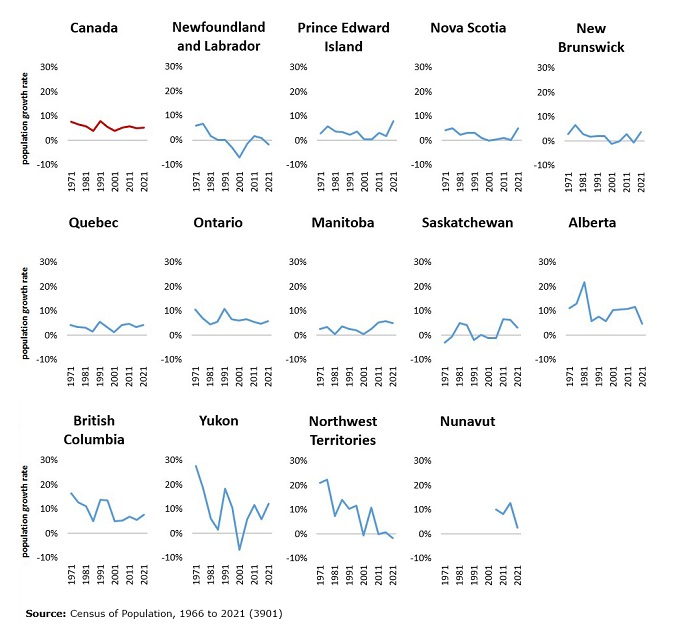Infographic 2
Population growth rate from 2016 to 2021 reaches 50-year record high in Prince Edward Island and in Nova Scotia while it slows to a record low in Alberta

Infographic description
The title of the infographic is "Population growth rate from 2016 to 2021 reaches 50-year record high in Prince Edward Island and in Nova Scotia while it slows to a record low in Alberta"
The following set of 14 line charts depicts the population growth rate for Canada, and the 13 provinces and territories from the 1966 to 1971 period to the 2016 to 2021 period.
For each of the 14 line charts:
The Y-axis title is population growth rate.
The X-axis is the census year, from 1971 to 2021 and it represent the end years of the 5-year periods.
Each chart displays on a line the population growth rate for the following 5-year periods: 1966/1971, 1971/1976, 1976/1981, 1981/1986, 1986/1991, 1991/1996, 1996/2001, 2001/2006, 2006/2011, 2011/2016, 2016/2021.
For Canada, the population growth rate for each of those periods, respectively, is as follows: 7.8%, 6.6%, 5.9%, 4.0%, 7.9%, 5.7%, 4.0%, 5.4%, 5.9%, 5.0%, 5.2%.
For Newfoundland and Labrador, the population growth rate for each of those periods, respectively, is as follows: 5.8%, 6.8%, 1.8%, 0.1%, 0.0%, -2.9%, -7.0%, -1.5%, 1.8%, 1.0%, -1.8%.
For Prince Edward Island, the population growth rate for each of those periods, respectively, is as follows: 2.9%, 5.9%, 3.6%, 3.4%, 2.5%, 3.7%, 0.5%, 0.4%, 3.2%, 1.9%, 8.0%.
For Nova Scotia, the population growth rate for each of those periods, respectively, is as follows: 4.4%, 5.0%, 2.3%, 3.0%, 3.1%, 1.0%, -0.1%, 0.6%, 0.9%, 0.2%, 5.0%.
For New Brunswick, the population growth rate for each of those periods, respectively, is as follows: 2.9%, 6.7%, 2.8%, 1.9%, 2.0%, 2.0%, -1.2%, 0.1%, 2.9%, -0.5%, 3.8%.
For Quebec, the population growth rate for each of those periods, respectively, is as follows: 4.3%, 3.4%, 3.3%, 1.5%, 5.6%, 3.5%, 1.4%, 4.3%, 4.7%, 3.3%, 4.1%.
For Ontario, the population growth rate for each of those periods, respectively, is as follows: 10.7%, 7.3%, 4.4%, 5.5%, 10.8%, 6.6%, 6.1%, 6.6%, 5.7%, 4.6%, 5.8%.
For Manitoba, the population growth rate for each of those periods, respectively, is as follows: 2.6%, 3.4%, 0.5%, 3.6%, 2.7%, 2.0%, 0.5%, 2.6%, 5.2%, 5.8%, 5.0%.
For Saskatchewan, the population growth rate for each of those periods, respectively, is as follows: -3.0%, -0.5%, 5.1%, 4.3%, -2.0%, 0.1%, -1.1%, -1.1%, 6.7%, 6.3%, 3.1%.
For Alberta, the population growth rate for each of those periods, respectively, is as follows: 11.3%, 12.9%, 21.7%, 5.7%, 7.6%, 5.9%, 10.3%, 10.6%, 10.8%, 11.6%, 4.8%.
For British Columbia, the population growth rate for each of those periods, respectively, is as follows: 16.6%, 12.9%, 11.3%, 5.1%, 13.8%, 13.5%, 4.9%, 5.3%, 7.0%, 5.6%, 7.6%.
For Yukon, the population growth rate for each of those periods, respectively, is as follows: 27.9%, 18.8%, 6.0%, 1.5%, 18.3%, 10.7%, -6.8%, 5.9%, 11.6%, 5.8%, 12.1%.
For Northwest Territories, the population growth rate for each of those periods, respectively, is as follows: 21.1%, 22.4%, 7.4%, 14.2%, 10.4%, 11.7%, -0.5%, 11.0%, 0.0%, 0.8%, -1.7%.
For Nunavut, the population growth rate is provided for the last four periods, and is as follows: 10.2%, 8.3%, 12.7%, 2.5%.
Source: Census of Population, 1966 to 2021 (3901).
- Date modified: